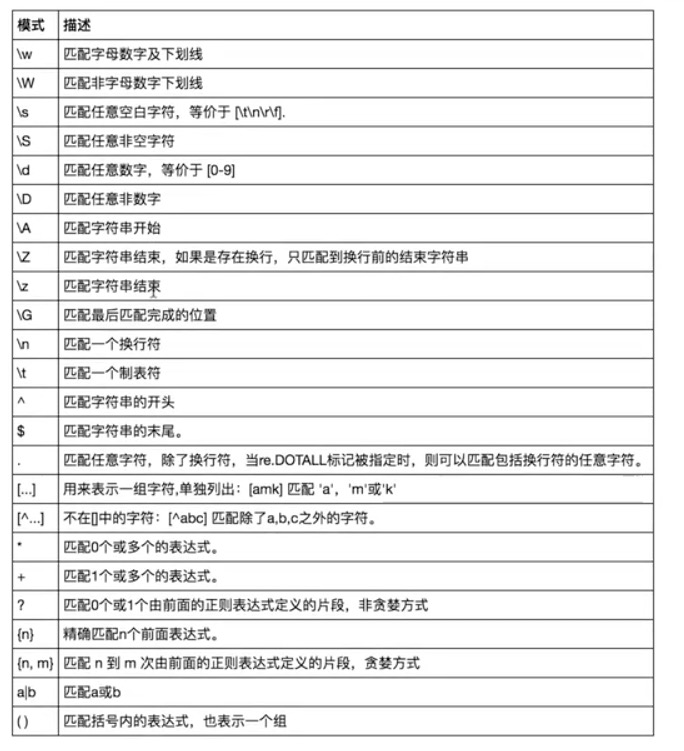python常用模块二正则表达式
正则表达式
常用的正则元字符

# =================================匹配模式=================================
#一对一的匹配
# 'hello'.replace(old,new)
# 'hello'.find('pattern') #正则匹配
import re
#\w与\W
print(re.findall('\w','hello egon 123')) #['h', 'e', 'l', 'l', 'o', 'e', 'g', 'o', 'n', '1', '2', '3']
print(re.findall('\W','hello egon 123')) #[' ', ' '] #\s与\S
print(re.findall('\s','hello egon 123')) #[' ', ' ', ' ', ' ']
print(re.findall('\S','hello egon 123')) #['h', 'e', 'l', 'l', 'o', 'e', 'g', 'o', 'n', '1', '2', '3'] #\n \t都是空,都可以被\s匹配
print(re.findall('\s','hello \n egon \t 123')) #[' ', '\n', ' ', ' ', '\t', ' '] #\n与\t
print(re.findall(r'\n','hello egon \n123')) #['\n']
print(re.findall(r'\t','hello egon\t123')) #['\n'] #\d与\D
print(re.findall('\d','hello egon 123')) #['1', '2', '3']
print(re.findall('\D','hello egon 123')) #['h', 'e', 'l', 'l', 'o', ' ', 'e', 'g', 'o', 'n', ' '] #\A与\Z
print(re.findall('\Ahe','hello egon 123')) #['he'],\A==>^
print(re.findall('123\Z','hello egon 123')) #['he'],\Z==>$ #^与$
print(re.findall('^h','hello egon 123')) #['h']
print(re.findall('3$','hello egon 123')) #['3'] # 重复匹配:| . | * | ? | .* | .*? | + | {n,m} |
#.
print(re.findall('a.b','a1b')) #['a1b']
print(re.findall('a.b','a1b a*b a b aaab')) #['a1b', 'a*b', 'a b', 'aab']
print(re.findall('a.b','a\nb')) #[]
print(re.findall('a.b','a\nb',re.S)) #['a\nb']
print(re.findall('a.b','a\nb',re.DOTALL)) #['a\nb']同上一条意思一样 #*
print(re.findall('ab*','bbbbbbb')) #[]
print(re.findall('ab*','a')) #['a']
print(re.findall('ab*','abbbb')) #['abbbb'] #?
print(re.findall('ab?','a')) #['a']
print(re.findall('ab?','abbb')) #['ab']
#匹配所有包含小数在内的数字
print(re.findall('\d+\.?\d*',"asdfasdf123as1.13dfa12adsf1asdf3")) #['123', '1.13', '12', '1', '3'] #.*默认为贪婪匹配
print(re.findall('a.*b','a1b22222222b')) #['a1b22222222b'] #.*?为非贪婪匹配:推荐使用
print(re.findall('a.*?b','a1b22222222b')) #['a1b'] #+
print(re.findall('ab+','a')) #[]
print(re.findall('ab+','abbb')) #['abbb'] #{n,m}
print(re.findall('ab{2}','abbb')) #['abb']
print(re.findall('ab{2,4}','abbb')) #['abb']
print(re.findall('ab{1,}','abbb')) #'ab{1,}' ===> 'ab+'
print(re.findall('ab{0,}','abbb')) #'ab{0,}' ===> 'ab*' #[]
print(re.findall('a[1*-]b','a1b a*b a-b')) #[]内的都为普通字符了,且如果-没有被转意的话,应该放到[]的开头或结尾
print(re.findall('a[^1*-]b','a1b a*b a-b a=b')) #[]内的^代表的意思是取反,所以结果为['a=b']
print(re.findall('a[0-9]b','a1b a*b a-b a=b')) #[]内的^代表的意思是取反,所以结果为['a=b']
print(re.findall('a[a-z]b','a1b a*b a-b a=b aeb')) #[]内的^代表的意思是取反,所以结果为['a=b']
print(re.findall('a[a-zA-Z]b','a1b a*b a-b a=b aeb aEb')) #[]内的^代表的意思是取反,所以结果为['a=b'] #\# print(re.findall('a\\c','a\c')) #对于正则来说a\\c确实可以匹配到a\c,但是在python解释器读取a\\c时,会发生转义,然后交给re去执行,所以抛出异常
print(re.findall(r'a\\c','a\c')) #r代表告诉解释器使用rawstring,即原生字符串,把我们正则内的所有符号都当普通字符处理,不要转义
print(re.findall('a\\\\c','a\c')) #同上面的意思一样,和上面的结果一样都是['a\\c'] #():分组
print(re.findall('ab+','ababab123')) #['ab', 'ab', 'ab']
print(re.findall('(ab)+123','ababab123')) #['ab'],匹配到末尾的ab123中的ab
print(re.findall('(?:ab)+123','ababab123')) #findall的结果不是匹配的全部内容,而是组内的内容,?:可以让结果为匹配的全部内容
print(re.findall('href="(.*?)"','<a href="http://www.baidu.com">点击</a>'))#['http://www.baidu.com']
print(re.findall('href="(?:.*?)"','<a href="http://www.baidu.com">点击</a>'))#['href="http://www.baidu.com"'] #|
print(re.findall('compan(?:y|ies)','Too many companies have gone bankrupt, and the next one is my company'))
基本用法
python提供的re中的方法
import re
#
print(re.findall('e','alex make love') ) #['e', 'e', 'e'],返回所有满足匹配条件的结果,放在列表里
#
print(re.search('e','alex make love').group()) #e,只到找到第一个匹配然后返回一个包含匹配信息的对象,该对象可以通过调用group()方法得到匹配的字符串,如果字符串没有匹配,则返回None。 #
print(re.match('e','alex make love')) #None,同search,不过在字符串开始处进行匹配,完全可以用search+^代替match #
print(re.split('[ab]','abcd')) #['', '', 'cd'],先按'a'分割得到''和'bcd',再对''和'bcd'分别按'b'分割 #
print('===>',re.sub('a','A','alex make love')) #===> Alex mAke love,不指定n,默认替换所有
print('===>',re.sub('a','A','alex make love',1)) #===> Alex make love
print('===>',re.sub('a','A','alex make love',2)) #===> Alex mAke love
print('===>',re.sub('^(\w+)(.*?\s)(\w+)(.*?\s)(\w+)(.*?)$',r'\5\2\3\4\1','alex make love')) #===> love make alex print('===>',re.subn('a','A','alex make love')) #===> ('Alex mAke love', 2),结果带有总共替换的个数 #
obj=re.compile('\d{2}') print(obj.search('abc123eeee').group()) #
print(obj.findall('abc123eeee')) #['12'],重用了obj
补充
import re
print(re.findall("<(?P<tag_name>\w+)>\w+</(?P=tag_name)>","<h1>hello</h1>")) #['h1']
print(re.search("<(?P<tag_name>\w+)>\w+</(?P=tag_name)>","<h1>hello</h1>").group()) #<h1>hello</h1>
print(re.search("<(?P<tag_name>\w+)>\w+</(?P=tag_name)>","<h1>hello</h1>").groupdict()) #<h1>hello</h1> print(re.search(r"<(\w+)>\w+</(\w+)>","<h1>hello</h1>").group())
print(re.search(r"<(\w+)>\w+</\1>","<h1>hello</h1>").group())
import re print(re.findall(r'-?\d+\.?\d*',"1-12*(60+(-40.35/5)-(-4*3))")) #找出所有数字['1', '-12', '60', '-40.35', '5', '-4', '3'] #使用|,先匹配的先生效,|左边是匹配小数,而findall最终结果是查看分组,所有即使匹配成功小数也不会存入结果
#而不是小数时,就去匹配(-?\d+),匹配到的自然就是,非小数的数,在此处即整数
print(re.findall(r"-?\d+\.\d*|(-?\d+)","1-2*(60+(-40.35/5)-(-4*3))")) #找出所有整数['1', '-2', '60', '', '5', '-4', '3']
#_*_coding:utf-8_*_
__author__ = 'Linhaifeng'
#在线调试工具:tool.oschina.net/regex/#
import re s='''
http://www.baidu.com
egon@oldboyedu.com
你好
010-3141
''' #最常规匹配
# content='Hello 123 456 World_This is a Regex Demo'
# res=re.match('Hello\s\d\d\d\s\d{3}\s\w{10}.*Demo',content)
# print(res)
# print(res.group())
# print(res.span()) #泛匹配
# content='Hello 123 456 World_This is a Regex Demo'
# res=re.match('^Hello.*Demo',content)
# print(res.group()) #匹配目标,获得指定数据 # content='Hello 123 456 World_This is a Regex Demo'
# res=re.match('^Hello\s(\d+)\s(\d+)\s.*Demo',content)
# print(res.group()) #取所有匹配的内容
# print(res.group(1)) #取匹配的第一个括号内的内容
# print(res.group(2)) #去陪陪的第二个括号内的内容 #贪婪匹配:.*代表匹配尽可能多的字符
# import re
# content='Hello 123 456 World_This is a Regex Demo'
#
# res=re.match('^He.*(\d+).*Demo$',content)
# print(res.group(1)) #只打印6,因为.*会尽可能多的匹配,然后后面跟至少一个数字 #非贪婪匹配:?匹配尽可能少的字符
# import re
# content='Hello 123 456 World_This is a Regex Demo'
#
# res=re.match('^He.*?(\d+).*Demo$',content)
# print(res.group(1)) #只打印6,因为.*会尽可能多的匹配,然后后面跟至少一个数字 #匹配模式:.不能匹配换行符
content='''Hello 123456 World_This
is a Regex Demo
'''
# res=re.match('He.*?(\d+).*?Demo$',content)
# print(res) #输出None # res=re.match('He.*?(\d+).*?Demo$',content,re.S) #re.S让.可以匹配换行符
# print(res)
# print(res.group(1)) #转义:\ # content='price is $5.00'
# res=re.match('price is $5.00',content)
# print(res)
#
# res=re.match('price is \$5\.00',content)
# print(res) #总结:尽量精简,详细的如下
# 尽量使用泛匹配模式.*
# 尽量使用非贪婪模式:.*?
# 使用括号得到匹配目标:用group(n)去取得结果
# 有换行符就用re.S:修改模式 #re.search:会扫描整个字符串,不会从头开始,找到第一个匹配的结果就会返回 # import re
# content='Extra strings Hello 123 456 World_This is a Regex Demo Extra strings'
#
# res=re.match('Hello.*?(\d+).*?Demo',content)
# print(res) #输出结果为None #
# import re
# content='Extra strings Hello 123 456 World_This is a Regex Demo Extra strings'
#
# res=re.search('Hello.*?(\d+).*?Demo',content) #
# print(res.group(1)) #输出结果为 #re.search:只要一个结果,匹配演练,
import re
content='''
<tbody>
<tr id="4766303201494371851675" class="even "><td><div class="hd"><span class="num">1</span><div class="rk "><span class="u-icn u-icn-75"></span></div></div></td><td class="rank"><div class="f-cb"><div class="tt"><a href="/song?id=476630320"><img class="rpic" src="http://p1.music.126.net/Wl7T1LBRhZFg0O26nnR2iQ==/19217264230385030.jpg?param=50y50&quality=100"></a><span data-res-id="476630320" "
# res=re.search('<a\shref=.*?<b\stitle="(.*?)".*?b>',content)
# print(res.group(1)) #re.findall:找到符合条件的所有结果
# res=re.findall('<a\shref=.*?<b\stitle="(.*?)".*?b>',content)
# for i in res:
# print(i) #re.sub:字符串替换
import re
content='Extra strings Hello 123 456 World_This is a Regex Demo Extra strings' # content=re.sub('\d+','',content)
# print(content) #用\1取得第一个括号的内容
#用法:将123与456换位置
# import re
# content='Extra strings Hello 123 456 World_This is a Regex Demo Extra strings'
#
# # content=re.sub('(Extra.*?)(\d+)(\s)(\d+)(.*?strings)',r'\1\4\3\2\5',content)
# content=re.sub('(\d+)(\s)(\d+)',r'\3\2\1',content)
# print(content) # import re
# content='Extra strings Hello 123 456 World_This is a Regex Demo Extra strings'
#
# res=re.search('Extra.*?(\d+).*strings',content)
# print(res.group(1)) # import requests,re
# respone=requests.get('https://book.douban.com/').text # print(respone)
# print('======'*1000)
# print('======'*1000)
# print('======'*1000)
# print('======'*1000)
# res=re.findall('<li.*?cover.*?href="(.*?)".*?title="(.*?)">.*?more-meta.*?author">(.*?)</span.*?year">(.*?)</span.*?publisher">(.*?)</span.*?</li>',respone,re.S)
# # res=re.findall('<li.*?cover.*?href="(.*?)".*?more-meta.*?author">(.*?)</span.*?year">(.*?)</span.*?publisher">(.*?)</span>.*?</li>',respone,re.S)
#
#
# for i in res:
# print('%s %s %s %s' %(i[0].strip(),i[1].strip(),i[2].strip(),i[3].strip()))
例子
测试例子:
http://tool.chinaz.com/regex/
参考
https://blog.csdn.net/yufenghyc/article/details/51078107
https://www.cnblogs.com/fozero/p/7868687.html
原文来自:http://www.cnblogs.com/linhaifeng/articles/6384466.html#_label13
python常用模块二正则表达式的更多相关文章
- Python常用模块二
一.time & datetime #_*_coding:utf-8_*_ import time # print(time.clock()) #返回处理器时间,3.3开始已废弃 , 改成了t ...
- Python常用模块(二)
一.json与pickle json与pickle模块是为了完成数据的序列化. 序列化是指把对象(变量)从内存中变成可存储或传输的过程,在Python中叫picking,在其他语言中也由其他的叫法,但 ...
- python:常用模块二
1,hashlib模块---摘要算法 import hashlib md5 = hashlib.md5() md5.update('how to use md5 in python hashlib?' ...
- python 常用模块 time random os模块 sys模块 json & pickle shelve模块 xml模块 configparser hashlib subprocess logging re正则
python 常用模块 time random os模块 sys模块 json & pickle shelve模块 xml模块 configparser hashlib subprocess ...
- python常用模块-1
一.认识模块 1.什么是模块:一个模块就是一个包含了python定义和声明的文件,文件名就是加上.py的后缀,但其实import加载的模块分为四个通用类别 : 1.使用python编写的代码(.py文 ...
- Python常用模块大全
Python常用模块大全 os模块: os.remove() 删除文件 os.unlink() 删除文件 os.rename() 重命名文件 os.listdir() 列出指定目录下所有文件 os.c ...
- python——常用模块
python--常用模块 1 什么是模块: 模块就是py文件 2 import time #导入时间模块 在Python中,通常有这三种方式来表示时间:时间戳.元组(struct_time).格式化的 ...
- python常用模块之subprocess
python常用模块之subprocess python2有个模块commands,执行命令的模块,在python3中已经废弃,使用subprocess模块来替代commands. 介绍一下:comm ...
- python常用模块-调用系统命令模块(subprocess)
python常用模块-调用系统命令模块(subprocess) 作者:尹正杰 版权声明:原创作品,谢绝转载!否则将追究法律责任. subproces基本上就是为了取代os.system和os.spaw ...
随机推荐
- ASP.NET开发实战——(二)为什么使用ASP.NET
本文主要内容是通过分析<博客系统>需求,确定使用Web应用的形式来开发,然后介绍了HTML.HTTP的概念,并使用IIS搭建了一个静态的HTML“页面”,从而引出“动态”的ASP.NET. ...
- 公共组件及脚手架webpack模板
一.公共组件的创建和使用 前面已经学习vue组件时,了解了公共组件,但在脚手架项目中只使用过局部组件.这里是讲解全局组件如何在脚手架项目中去使用. 1.创建全局组件 在src/components/C ...
- MACbook关机开机的咚咚咚声音
在MAC系统中,设置→声音设置→内置扬声器静音即可. windows下面没有试过.
- [LeetCode] 190. Reverse Bits 颠倒二进制位
Reverse bits of a given 32 bits unsigned integer. Example 1: Input: 00000010100101000001111010011100 ...
- API加密框架原理解密
关于框架的使用文章请参考: 前后端API交互如何保证数据安全性?:http://cxytiandi.com/blog/detail/20235 API数据加密框架monkey-api-encrypt: ...
- swagger Unable to render this definition
Unable to render this definition The provided definition does not specify a valid version field. Ple ...
- (四)golang--注意事项
以.go为结尾: 执行入口是main()函数: 区分大小写: Go方法由一条条语句构成,每个语句后不需要加问号: Go编译器是一行行进行编译的,一行不能写多条语句: go语言定义的变量或者import ...
- hbase 查看元数据
package com.jason.lala.pipe.dbinfo import com.jason.lala.common.query.option.HbaseOptions import org ...
- Java for循环每次都通过list.size()和 string.length()获取大小是否消耗性能?
前言 有人说在for循环之前用一个局部变量先获取到list.size().str.length(),然后在for循环的判断条件里通过这个局部变量替换list.size().str.length()会节 ...
- NIO ByteBuffer的allocate与allocateDirect区别(HeapByteBuffer与DirectByteBuffer的区别)
在Java中当我们要对数据进行更底层的操作时,一般是操作数据的字节(byte)形式,这时经常会用到ByteBuffer这样一个类. ByteBuffer提供了两种静态实例方式: public stat ...
